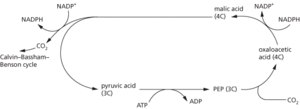The metabolic pathway followed in the light-independent phase of photosynthesis by tropical plants, such as sugar cane and maize, and by plants that live in arid environments; these plants are known as C4 plants. The initial fixation of atmospheric carbon dioxide occurs with phosphoenolpyruvate (PEP), through the mediation of the enzyme PEP carboxylase, to form the four-carbon compound oxaloacetic acid (see illustration; compare c3 pathway). Oxaloacetic acid is then converted into malic acid; this breaks down to give carbon dioxide, which passes to the Calvin–Bassham–Benson cycle, and pyruvic acid, which generates more PEP, thereby ensuring a constant supply of this compound for further carbon dioxide fixation. The C4 pathway allows photosynthesis to occur at very low concentrations of carbon dioxide as PEP carboxylase has an extremely high affinity for carbon dioxide. This pathway also works well at high temperatures and light intensity, enabling efficient photosynthesis in tropical plants. In addition, the malic acid formed can be stored before being used, to be later broken down to carbon dioxide when required in the Calvin–Bassham–Benson cycle. This is important in desert plants, which need to close their stomata during the day to reduce water loss (see crassulacean acid metabolism). The anatomy of the C4 plant leaf is adapted to suit this metabolic pathway (see bundle sheath cells).

C4 pathway
- cyclotetramethylenetetranitramine
- cyclothem
- cyclotomic polynomial
- cyclotron
- cyclotron maser
- cyclotron radiation
- cyclotron resonance
- CYC project
- CYGNSS
- Cygnus
- Cygnus A
- Cygnus Loop
- Cygnus Rift
- Cygnus ((spacecraft))
- Cygnus X-1
- cylinder
- cylinder gas
- cylindrical
- cylindrical polar coordinates
- cylindrical trend
- cylindrical winding
- cylindroid
- cylindroidal fold
- cymatogeny
- Cymbeline (42)